The feeding of deer by some Port Townsend residents has led to an excessively large deer population and may be creating a health and safety crisis, Uptown District residents told members of the City …
This item is available in full to subscribers.
We have recently launched a new and improved website. To continue reading, you will need to either log into your subscriber account, or purchase a new subscription.
If you had an active account on our previous website, then you have an account here. Simply reset your password to regain access to your account.
If you did not have an account on our previous website, but are a current print subscriber, click here to set up your website account.
Otherwise, click here to view your options for subscribing.
* Having trouble? Call our circulation department at 360-385-2900, or email our support.
Please log in to continue |
|
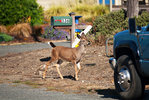
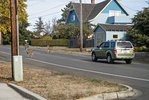
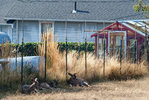
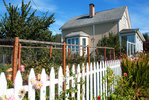
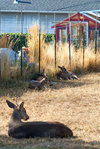
The feeding of deer by some Port Townsend residents has led to an excessively large deer population and may be creating a health and safety crisis, Uptown District residents told members of the City Council Oct. 2.
City Manager David Timmons said he would talk with Police Chief Michael Evans and City Attorney Steve Gross to see what could be done.
“I know it’s a major nuisance,” Timmons said of the deer, adding that more could be done if the deer problem were deemed a public health or safety issue.
“We will look into it. There has been a lot of headway made on the sterilization program, and I think that that’s probably the most beneficial for us to look into,” Timmons said.
At least four people shared their concerns about deer with the council.
Jo Chandler, who lives near Lawrence and Cass streets, said a nearby neighbor “is a well-known deer feeder, deer breeder, [who is] feeding and breeding herds of deer.
“I do have some photos of him feeding the deer, which he’s very proud of. Herds of hand-fed deer increase disease transmission such as bovine TB, a chronic, infectious disease of deer that, as a nurse, I know can be transmitted to humans from their exhaled air, sputum, urine, feces and direct contact,” Chandler said. “Hand feeding causes overpopulation, fleas, ticks and inbreeding deformities, which we see every day.”
Chandler also said people are honking at deer and their fawns as they cross the street and that a deer had recently been struck by a car where she lived.
“Its legs quivering, trying to get up, bleeding profusely from its head,” as other cars swerved, trying not to strike the deer a second time, she said of what she saw as a safety hazard.
Lynne Stryker, who also lives in Uptown, was concerned about both public safety and the humane treatment of wildlife. She said driving in the area was challenging due to uncontrolled intersections, plants that block visibility and plentiful deer.
“It’s a daily occurrence for me to watch deer being injured near my home,” Stryker said.
“We woke up to just a horrible deer carcass within the last week … hideous thing that someone had hit overnight. My concern is we need to be responsible for public safety and for the humane treatment of the injured deer here.”
Her next-door neighbor had a dead deer in her yard, but the neighbor was unable to drag it away.
“Someone obviously hit it and left. And this is a really common situation in Port Townsend.”
Stryker suggested that the city could put up some “deer crossing” signs.
“My hope is we could stop feeding the wild animals, but that’s a whole ’nother subject. We’ve got herds of deer – 20 to 30 – that literally wander in a pack down Cass Street.”
Forest Shomer, who lives on Chestnut Street, said he’s studied how other places – including Staten Island, New York; Ann Arbor, Michigan; Vancouver, British Columbia; Victoria, British Columbia; and Bellingham, Washington, have dealt with the problem of deer infestations.
“This is not something that only Port Townsend is dealing with,” as the other cities are “all dealing with the same issue: no predators and uncontrolled multiplying deer populations,” he said.
Shomer recalled a big snowstorm in 1984 when he went out to his garden and was “surprised to see deer tracks in the garden. In those days, that was very unusual … that was 33 years ago. So that’s how much things have changed.”
The city should take action, Shomer said, either by making it illegal to feed deer or by sterilizing them.
Even fences aren’t a solution to the deer problem.
“Do we want to live in a town that has every house enclosed in an 8-foot wire fence?” Shomer asked.
Furthermore, he said, the properties that have fences are diverting deer to places that are not yet fenced, putting pressure on people who cannot afford a high fence.
“This will only fester and get worse until we put focused attention on it,” he said.
Joan Fabian, who lives in the same neighborhood, said she’s lived in Port Townsend for 33 years and that someone in the area regularly feeds deer out of his hand. Deer have also knocked down parts of her wooden fence while rubbing their antlers against it, she said.
Raccoons are also attracted to the deer food, she said, and the raccoons have damaged her roof and also used part of her yard as a “raccoon latrine.”
“I’ve sustained a lot of property damage,” Fabian said.
“There are concerns also with, again, the privilege of one person feeding the deer and causing multiple people in the neighborhood the expense of even putting up a new 6-foot fence, when that is the limit of fencing that we can do,” she said.
Residents in the area are also faced with managing deer feces, she said, and “the food being left out has allowed for escalation of the rat population.”
Fabian asked council members to make it illegal to feed wildlife in city limits.
“The operative word is keeping them ‘wild,’” she said.